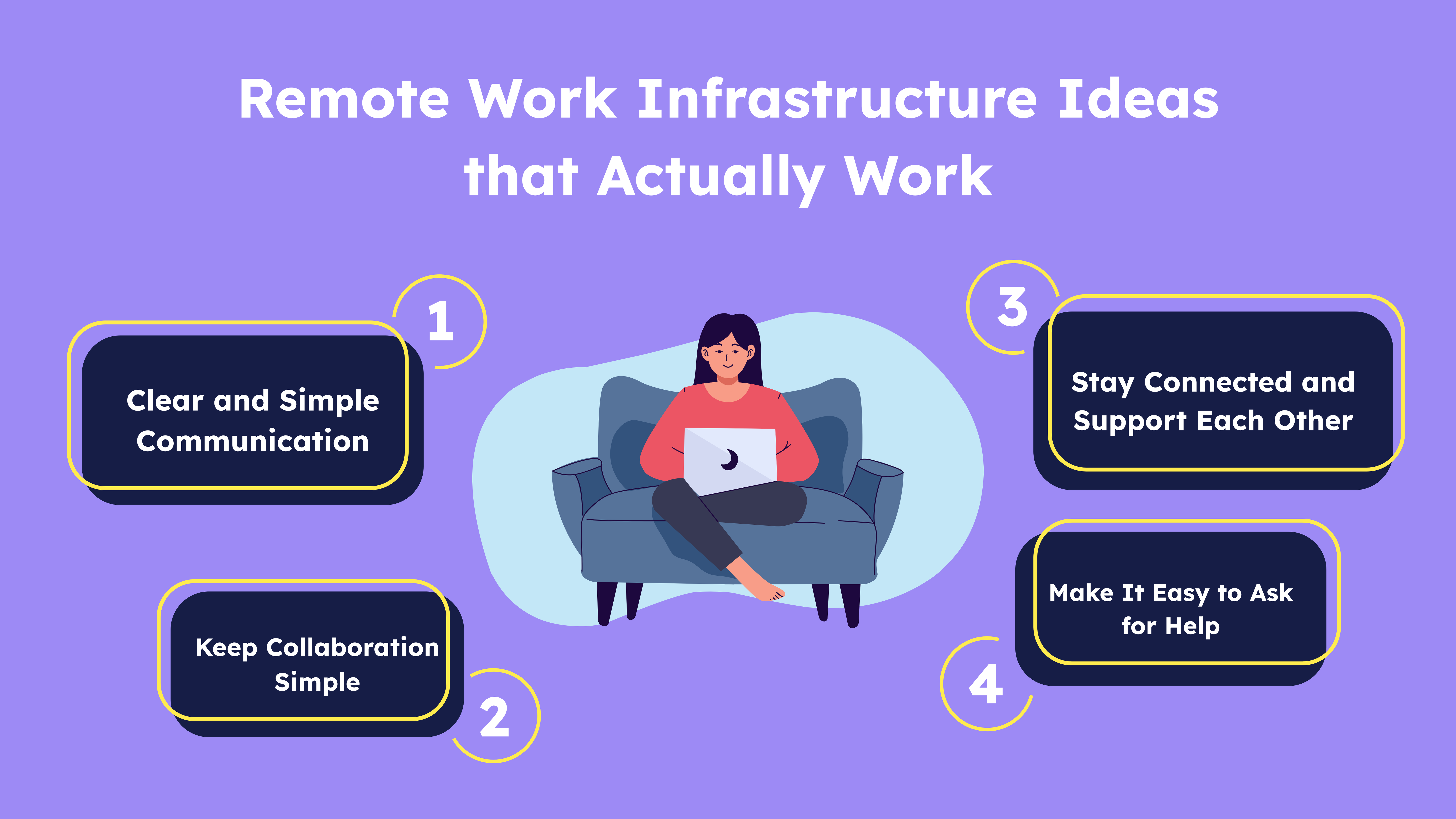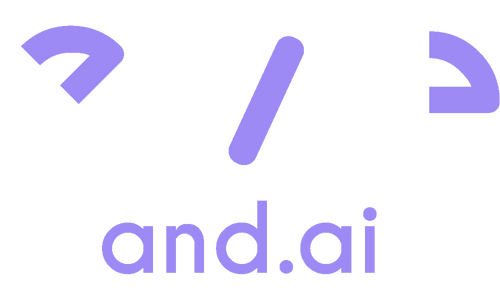You’ve probably felt it: back-to-back virtual meetings, scattered files, and a growing sense of isolation. Remote work was supposed to be easier, but the reality can be stressful, confusing, and exhausting. Teams miss deadlines, managers scramble to stay on top of projects, and employees may feel unnoticed.
This article shares practical ways to build a smooth remote work infrastructure. From tools that keep teams in sync to strategies that reduce stress, we show how to make remote work solutions productive, engaging, and supportive for everyone.
Why Remote Work Infrastructure Matters
Investing in a solid remote work infrastructure is no longer optional — it’s essential for maintaining remote team productivity, collaboration, and employee satisfaction. Poorly managed distributed teams often experience:
- Remote team communication gaps: Employees working in silos or across time zones can miss updates or project deadlines.
- Low remote employee engagement: Without proper oversight and team interaction, employees may feel disconnected from company goals.
- Burnout risks: Remote workers can struggle with blurred work-life boundaries, leading to stress and fatigue.
A well-implemented infrastructure ensures teams stay connected, aligned, and motivated while maintaining high performance.
Key benefits of robust remote infrastructure:
- Supports seamless communication across teams and departments
- Enhances collaboration efficiency and workflow management
- Helps reduce remote work stress and risk of burnout
- Promotes employee engagement and wellbeing
- Empowers HR leaders to prevent burnout in remote teams
- Forms the foundation for creating a resilient remote workforce
Key Challenges in Remote Work
Working remotely can sound ideal, but in reality, many employees and teams face remote work challenges that affect their work and wellbeing every day. Here are the most common struggles, told in a way that feels close to real life:
1. Communication Breakdowns
-
You send a message to your teammate, but they’re in a different time zone, so the reply comes hours later — now your project is delayed.
- Important updates get buried in long email threads or multiple chat apps, leaving everyone confused about what’s actually next.
- Managers don’t always know when employees are struggling, and employees hesitate to ask for help because they feel out of sight.
2. Collaboration Struggles
-
You’re juggling multiple documents in different locations, and no one knows which version is the latest.
- Scheduling meetings across global teams is like solving a puzzle, leaving less time for actual work.
- Tasks fall through the cracks because everyone assumes someone else is handling them.
🔧 A common remote work solution is to streamline shared platforms, but culture and clarity matter just as much.
3. Feeling Alone and Overwhelmed
-
You’re juggling multiple documents in different locations, and no one knows which version is the latest.
- Scheduling meetings across global teams is like solving a puzzle, leaving less time for actual work.
- Tasks fall through the cracks because everyone assumes someone else is handling them.
🔧 A common remote work solution is to streamline shared platforms, but culture and clarity matter just as much.

Remote work challenges don’t have to feel chaotic or lonely. The key is building small, practical habits and systems that help teams communicate clearly, collaborate efficiently, and feel connected — without adding stress or complexity.
1. Clear and Simple Communication
-
Set expectations for responses: Agree as a team on how quickly messages should be answered and which channels to use for urgent vs. non-urgent updates.
- Daily or weekly check-ins: A 10–15 minute team huddle can keep everyone aligned and reduce misunderstandings.
- Make instructions visible: Use shared notes or a simple project board to ensure everyone knows what’s next, so nobody has to chase others for updates.
✅ These strategies help manage distributed teams more effectively and improve remote team communication.
2. Keep Collaboration Simple
-
Share one source of truth: Make it easy to find the latest documents and project info. Even a simple shared folder or a pinned message can prevent version confusion.
- Break projects into small steps: Assign clear, actionable tasks so everyone knows exactly what they are responsible for.
- Use asynchronous updates when needed: Not everyone is online at the same time — quick updates in a shared space save hours of repeated meetings.
🧩 Need ideas on how to improve remote team collaboration? Start with visibility, clarity, and simple tools.
3. Stay Connected and Support Each Other
-
Check in casually: Send a quick “How’s your day?” or schedule short coffee breaks to maintain social connection.
- Recognize effort: Acknowledge accomplishments — small wins boost morale and remote employee engagement.
- Encourage boundaries: Remind team members it’s okay to log off at a set time — overworking leads to burnout.
🧠 These support practices strengthen both employee wellbeing in remote work and team trust.
4. Make It Easy to Ask for Help
-
Normalize asking for support: Employees should feel comfortable sharing struggles without fear of judgment.
- Create quick access to resources: Even simple mental health check-ins or peer support channels help employees feel seen.
- Follow up regularly: Managers can schedule short one-on-one chats to check workload and stress levels — preventing problems before they escalate.
💬 These are easy ways to support employee mental health while working remotely, especially when using integrated employee wellbeing programmes.
Addressing Remote Work Depression: Keeping Teams Healthy and Engaged
Remote work can feel liberating, but it can also create quiet stress and isolation that builds up over time. Employees may log in on time, complete tasks, and meet deadlines — yet feel drained or demotivated.
1. Encourage Regular Check-Ins
- Short, personal conversations
- Quick pulse surveys
- Group check-ins
These are low-effort, high-return strategies that help reduce remote work stress and keep emotional temperature in check.
2. Support Work-Life Boundaries
- Set clear “offline” hours
- Respect breaks and recharge time
- Lead by example as a manager
Aligning with flexible work policies and flexible working arrangements reduces pressure and improves employee engagement and wellbeing.
3. Promote Social Connection
-
Virtual coffee chats or peer buddy systems
- Celebrate milestones
- Shared non-work spaces (e.g. playlists, book clubs)
These informal moments can go a long way toward preventing burnout in remote teams and boosting morale.
4. Provide Easy Access to Support
-
Mental health resources and toolkits
- Normalizing help-seeking behavior
- Using simple tools like AI-based check-ins or surveys
These are practical examples of corporate health wellness programs designed for the digital age.
How to Measure the Impact of Remote Work Infrastructure?
What does success look like?
- Remote team productivity: Are outcomes improving?
- Engagement metrics: Do employees feel heard and seen?
- Turnover & burnout: Are these going down?
- Mood trends & stress levels: Are you spotting issues early?
Tracking these KPIs reveals whether your current remote work solutions are effective — and where to adjust.
Making Remote Work Work for Everyone
Remote work doesn’t have to mean stress, confusion, or isolation. By understanding the real remote work challenges — from communication breakdowns and collaboration struggles to feelings of loneliness and burnout — companies can take small, actionable steps that make a big difference.
Focusing on clear communication, simple collaboration strategies, social connection, and proactive mental health support empowers employees to stay engaged, productive, and motivated. Managers, HR leaders, and decision-makers can foster a work environment where teams feel seen, supported, and connected — even from a distance.
Take the Next Step
eve & ai helps organizations build remote work infrastructure that works — combining wellbeing insights, early risk detection, and practical support for employees.
Book a demo to explore our solution today:
- Strengthen remote employee engagement
- Boost remote team productivity
- Implement smart, empathetic workplace productivity tips
- Foster long-term employee wellbeing in remote work





